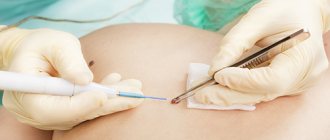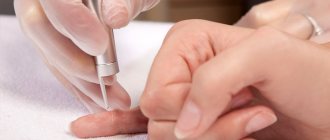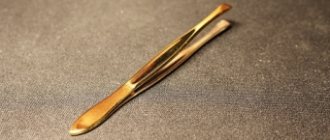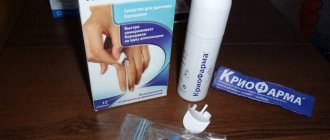Cryodestruction is a modern method of treating superficial benign neoplasms, based on cooling tissues to extremely low temperatures and their subsequent destruction . In fact, cryodestruction belongs to the field of cryosurgery and is considered a surgical treatment method.
Cryodestruction with liquid nitrogen is widely used in cosmetology, dermatology and medicine. For example, cryodestruction of warts, condylomas, papillomas and other neoplasms is popular. The procedure is widely used to treat vascular formations and cervical erosion. In many cases, it can successfully replace surgery.
Indications for cryodestruction
Cryodestruction with liquid nitrogen is indicated for various pathologies that are infectious in nature or related to skin defects. The most common is cryodestruction of warts. This method is widely used to remove various neoplasms of pigmented or vascular type: nevi, hemangiomas, papillomas, condylomas, pigmentary granulomas, hyperkeratosis, squamous cell carcinoma, epidermal cyst, melanoma, mastocytoma.
Cryodestruction with liquid nitrogen is widely used in gynecology for cervical erosion, condylomas and papillomas of the vagina and vulva, ectopia of columnar epithelium, cervical dysplasia, cervical leukoplakia and other gynecological diseases.
Tumor removal using cryodestruction
Minimally invasive methods that allow the principle of radicalism in tumor removal are becoming increasingly widespread in oncology. Cryodestruction of tumors is one such method. Cryodestruction (from the Greek “kryos” - cold) is the destruction of tumor tissue using local exposure to ultra-low temperatures (from -90 to -200 degrees Celsius). For this, liquid nitrogen or argon is used.
Microscopic changes during tissue freezing include:
- instant freezing of intercellular and intracellular fluid
- the formation of many tiny ice crystals, providing an additional damaging effect
- critical increase in the concentration of toxic substances inside cells
- disruption of the blood supply to tumor cells due to destruction of capillaries
As a result, cells exposed to cold become nonviable and die. In the area where the cold source is applied, the following zones are formed:
- cryonecrosis with dead cells
- irreversible cryodamage, where cells are sure to die
- hypothermia, where most but not all cells die
To ensure guaranteed destruction of the tumor, the cryonecrosis zone is planned with some “reserve”, deliberately sacrificing some healthy cells. This allows you to avoid local recurrence of the tumor and its spread throughout the body in the future.
The impact on tumors is carried out using cryoprobes with attachments of different shapes to ensure their tight contact with the tumor. As the temperature of the probe decreases, it adheres tightly to the underlying tissue and freezes it to the desired depth within 30-120 seconds. The temperature of the probe then increases and it is easily separated. The accuracy of the impact is controlled by ultrasound, computer and magnetic resonance imaging. Equipment for cryodestruction provides the specified temperature and time, area and depth of exposure.
The procedure is practically painless. When the tissue is frozen, patients only feel a slight tingling or burning sensation. Therefore, anesthesia is not required to treat tumors located on the skin. The insertion of a probe into internal organs, for example, into the prostate gland, is performed under local anesthesia or general anesthesia through short puncture incisions. They are performed by a specialist in interventional radiology, in an operating room equipped with devices to visualize movement and correctly position the cryoprobe in the tumor tissue. Sometimes up to eight cryoprobes are required. And even in this case, there is no need to suture the wound; a tight bandage is enough.
Over the course of two to six weeks, the tissues necrotic due to cold are gradually rejected by the body, and the defect is filled with healthy cells with virtually no scar formation. This is especially important in the treatment of skin tumors, as well as for preserving organ function. For example, in the treatment of precancerous diseases and the initial stages of cervical cancer in young nulliparous women.
Cryodestruction is an excellent alternative to surgery for patients with early stages of cancer and contraindications for traditional surgery. The most common areas of application of this type of treatment are:
- malignant skin tumors without signs of metastasis - squamous cell carcinoma and basal cell carcinoma
- early stage melanoma
- nevi, hyperkeratosis and other skin processes with a high risk of malignancy
- primary and metastatic liver cancer
- kidney cancer
- lungs' cancer
- prostate cancer
- Cervical cancer
The cryodestruction method is now actively developing, and the list of indications for it is expanding.
The advantages of cryodestruction are obvious:
- minimally invasive intervention
- The method is quite simple for an experienced specialist
- the intervention is short and easily tolerated
- during the rehabilitation period the use of analgesics is almost never required
- minimized risk of relapse
- Treatment of superficial lesions does not require anesthesia; in other cases it is short-term
- provides a stable effect
- the intervention area does not bleed, since it eliminates the vascular network of the tumor
- no stitches required
- as necrotic masses are rejected, the defect is replaced by healthy tissue, so scars are almost not formed, which provides an excellent functional and cosmetic effect
Cryodestruction is not used if:
- the tumor is large
- the tumor has spread beyond the organ or there are distant metastases, since the effect is manifested only in the area of contact of the cooled applicator with the tumor mass
- there are infectious or inflammatory diseases in the acute stage
- the patient suffers from severe respiratory, cardiac, renal or liver failure
Thus, cryodestruction is a minimally invasive method of local exposure to ultra-low temperatures on a tumor in order to destroy it. Thanks to the use of imaging techniques, it allows treatment to be performed with maximum precision. All parameters (temperature, duration, area and volume) of the procedure are automatically controlled, so the risk of complications is minimal. Excellent for removing localized tumors of the skin and small internal organs without signs of spread.
Operating principle of cryodestruction
The procedure is performed using special equipment (cryodestructor) or liquid nitrogen. When using the hardware method, the tip of the applicator is pressed against the required area, after which it is cooled to a temperature of -180-190 degrees Celsius. When using liquid nitrogen, a cotton swab is soaked in it, and then simply applied to the damaged tissue for a short period of time (no more than 2-3 minutes).
The procedure involves instant cooling of tissues due to exposure to ultra-low temperatures. As a result, the intracellular and intercellular fluid freezes, the vital activity of cells is disrupted, protoplasm stops and microcirculation in the pathological tissue is disrupted. Tissue destruction occurs. After cryodestruction, the destroyed tissues are gradually replaced with healthy ones.
How to prepare and what to do after the procedure
Before you go for the procedure of removing papillomas with liquid nitrogen, you must consult with your doctor. Specialists must study the tumor, exclude oncological aspects, and only then admit the patient to cryodestruction. If the patient is experiencing an acute phase of infection at the time of contacting a specialist, the procedure should be postponed until complete recovery. A week before cryodestruction, you should not take anticoagulants.
After cryodestruction has been carried out, swelling appears at the site of the former papilloma, and the areas underneath harden and darken. After necrosis of the tumor tissue, a scab appears, which is rejected only a few weeks after the procedure. The scab acts as a protective layer that prevents germs from entering the wound. The scab cannot be removed on its own; this can only be done by a doctor if the scab does not fall off on its own.
When very large tumors are removed, blisters with serous or hemorrhagic contents appear in their place, which under no circumstances should be opened. The blister will break on its own within 1 week, and after that you will need to apply a sterile bandage in its place.
During the first week after cryodestruction, the site of the former neoplasm cannot be covered with cosmetics. You can wash the wound with soap, but you cannot rub it with a washcloth. In the future, when everything has healed and a new epithelium has appeared, it is not recommended to expose the skin to direct sunlight, treating it with a cream with a high radiation protection factor.
Stages of cryodestruction
For different purposes, different tips are used, which are selected depending on the size of the surface. In this case, the planes of contact must be parallel.
The cryodestruction process is divided into the following stages:
- Freezing tissue using liquid nitrogen. In this case, the tissue becomes dense, cold, white and insensitive. This is often accompanied by a tingling sensation, a slight burning sensation and mild pain.
- After cryodestruction, collateral edema and hyperemia occurs, lasting from 1 to 3 hours.
- The appearance of epidermal blisters, which disappear after 6-24 hours.
- Necrosis is completely rejected within 2-6 weeks. After cryodestruction, an inconspicuous spot remains, and the process of epithelization of the defect and surrounding tissue begins.
- Complete tissue regeneration occurs in about six months.
Cryodestruction in dermatology
In dermatology, liquid nitrogen is used to remove:
- age spots;
- hemangiomas;
- nevi;
- corns;
- neoplasms of viral origin: papillomas, condylomas and warts.
Sometimes the method is used to treat certain types of skin cancer. Contraindications for surgical intervention are purulent-inflammatory processes. Cryodestruction of warts and other skin tumors proceeds according to the following scheme.
- Liquid nitrogen is supplied with a tip to the area where the pathologically altered tissues are located. Sometimes skin areas are treated with cotton swabs soaked in the reagent.
- The skin turns white, becomes thicker, tolerable pain and tingling may occur, but in most cases the sensitivity completely disappears. Within 1.5-3 hours after the procedure, swelling appears and blisters appear - as with normal frostbite. They contain fluid of serous or hemorrhagic origin.
- Healing begins within 14-40 days, depending on the size of the affected area and individual response to surgery.
- The necrotic tissue is rejected, the pink spot that remains in place of the bubble begins to epithelialize. The regeneration process ends after 6 months. The quality of the skin at the site of freezing corresponds to that of healthy surrounding tissue.
- Cryodestruction of papillomas and condylomas eliminates the recurrence of tumors only in the area in which the operation was performed. Since these neoplasms are of viral etiology, there is no guarantee that as the activity of the virus increases, similar neoplasms will not appear on other areas of the skin.
Benefits of cryodestruction
Cryodestruction with liquid nitrogen has a number of undoubted advantages:
- the area of necrosis does not bleed;
- does not leave scars or scars;
- ease of procedure;
- cryosurgery does not require pain relief, since rapid cooling produces an analgesic effect;
- minimal injury;
- speed of the method;
- stable desired effect;
- cryodestruction is tolerated easily and painlessly;
- does not require lengthy preoperative preparation;
- during and after the procedure, metastasis stops;
- no relapses;
- does not require postoperative care or stitches.
Pros and cons of the procedure
Liquid nitrogen is used for cryodestruction. After its exposure, intracellular water instantly freezes, ice microcrystals damage membranes inside cells, cellular structures are destroyed, and the movement of protoplasm in neoplasms stops.
The procedure lasts from 25 seconds to 2 minutes. The difficulty of the operation of exposure to liquid nitrogen lies in the correct determination of the boundaries of the area that needs to be frozen.
Under the influence of low temperatures, a cryonecrosis zone is formed - a transition line between the freezing zone and the hypothermia zone. In the hypothermia zone, irreversible cryodamage occurs.
The area of freezing is always deeper than the actual zone of degenerated tissue.
The tip through which liquid nitrogen is supplied should reflect as accurately as possible the surface where the damaged tissue was located. At first, the tip seems to stick to the skin, but as it cools to a minimum temperature (-80°C), it easily separates from the surface of the epidermis.
The positive qualities of the operation include the following factors:
- You don’t have to think about pain relief, since exposure to low temperatures has an analgesic effect;
- There is no bleeding;
- The procedure is quite easy and does not require special training or many years of practice;
- There are no postoperative scars;
- The risk of metastasis is minimal;
- There are no relapses after the procedure;
- Postoperative care and rehabilitation are not required;
- It is easily tolerated, traumatic effects are minimized, intoxication does not occur;
- Cosmetic defects do not appear;
- When benign neoplasms are rejected, they are immediately replaced by healthy epidermal tissue that has undergone cryogenic treatment.
For many neoplasms, such as papillomas and warts, this method of removal is universal and does not require preoperative preparation.
Disadvantages of the procedure:
- Tissue restoration is quite long - sometimes it takes up to 3 weeks to heal;
- Not only the neoplasm is frozen, but also the surrounding tissue.
In some cases, after the procedure, it is necessary to carry out conventional surgical operations using the open method, if the tumor turns out to be larger in size than expected, or access to it is difficult - the tip cannot be pressed tightly.
Consequences
As with other methods of physical influence, complications may arise after cryodestruction. They develop infrequently, but the possibility of developing undesirable consequences cannot be completely excluded.
Exceeding the force and time of impact on the formation tissue can lead to a burn, and subsequently to the formation of a rough scar. Therefore, you need to be very responsible when choosing a clinic and a doctor. The accuracy of cauterization directly depends on the professionalism and practical experience of the doctor.
Failure to carry out aseptic treatment during the recovery period can lead to another complication - wound infection. Therefore, responsibility for the result lies not only with the doctor, but also with the patient.
What warts are removed by cryodestruction?
Based on their morphological structure and localization, warts are classified into several types.
- Ordinary (vulgar). Painless, dense and keratinized, round structures with a rough surface. The size of the formations varies from 1-2 mm to 5 mm. Closely spaced warts can merge into large plaques. They are most often localized on the hands, less often they affect the skin of the face.
- Plantar. A type of common wart, which is a rounded growth of a dirty gray color. They are distinguished by a deeper location in the skin tissues and larger sizes (up to 2 cm). They are localized on the foot in places that experience the greatest friction from the shoe. Causes severe pain while walking.
- Youth (flat). Small (up to 3 mm) dense formations of flesh-colored or pink color have an irregular rounded shape (usually the appearance of nodules) and a smooth surface. They appear mainly in young people and are localized mainly on the face and hands. Painful when touched. Most often they occur in places of mechanical damage to the skin (scratches, abrasions, cuts).
All of the listed types of warts can be removed using cryodestruction. In some cases, if the wart is located on the neck, face, hands and other open areas of the body, removal is only cosmetic in nature and allows you to get rid of aesthetic discomfort. However, there are situations when wart removal is mandatory.
Possible complications after cryodestruction
Cryodestruction is well tolerated by patients and has an extremely low rate of complications.
Thus, in the affected area when used externally (in the treatment of skin tumors), pigment spots may appear, a decrease in the pain threshold and a lack of hair growth may be observed. This can happen if the patient damages the skin bubble with liquid that forms on the skin after using the cryodestruction method.
To avoid possible complications, patients undergoing cryotherapy are advised to minimize exposure to ultraviolet rays and avoid overheating or hypothermia for two weeks.
Cryodestruction has a good cosmetic effect, but in order for it to be maximum, proper care of the postoperative wound should be provided.
Wound care after burning
Immediately after burning, the wound can be treated with salicylic alcohol. Will reduce the risk of infection, reduce swelling of the bladder from the accumulation of hemorrhagic fluid.
To speed up recovery after cryotherapy you must:
- isolate the skin from prolonged sunlight;
- do not allow the bubble to burst spontaneously;
- do not wet the crust until it falls off completely;
- do not remove the crust yourself;
- do not use cosmetics if the growth is located on the face;
- do not wear tight or chafing clothes, do not rub with a washcloth, avoid injuring the area (in a crowded subway);
- treat with salicylic alcohol or take a course of fucorcin;
- do not use hormonal drugs, do not use potent medications, tablets, traditional medicines, ointments without a doctor’s indication.
Additionally, you can take vitamin complexes. Before use, you need to read the dosages in the instructions. The goal is to strengthen the immune system and reduce the risk of wart degeneration.
If a new formation begins to appear at the site of cryodestruction, you should immediately consult a doctor. There is a high probability of a malignant growth.
Methodology
You can cauterize a wart with liquid nitrogen at a medical center or cosmetology clinic. At the initial consultation, the specialist examines the affected areas of the skin, determines the type, quantity, and size of tumors. The specialist can write out a referral for tests - this will help avoid unexpected complications during the procedure. In some cases, for example, if the size of the formation is very small, the doctor may recommend postponing the procedure for a while.
Cryodestruction can be carried out using:
- a special apparatus for cryogenic freezing - a cryoapplicator (nozzles of various diameters and configurations connected to a reservoir containing liquid nitrogen);
- an ordinary applicator (a wooden stick with a cotton swab, which is moistened with liquid nitrogen);
- freezing spray.
A special cryoapplicator is most convenient to use.
Procedure steps:
- treating the skin in the area of intended exposure with an antiseptic;
- applying a special gel or cream to the wart to soften the upper keratinized layer of the formation;
- exposure of the wart with a tip connected to a reservoir containing liquid nitrogen (the diameter of the nozzle should be 1.5 mm larger than the size of the wart) or an applicator dipped in liquid, or spraying the tumor with a spray.
The exposure time varies between 10-30 seconds. The procedure is repeated several times as the liquid nitrogen evaporates quickly. Under the influence of the active substance, the wart turns white, then a white border appears around the formation, which becomes a signal to stop the procedure.
Experts claim that cauterizing warts with nitrogen is a virtually painless procedure. Patients may feel a slight burning or tingling sensation, discomfort, and slight soreness. But all unpleasant symptoms disappear within a few seconds.
The severity of discomfort during cryodestruction depends on the location and size of the wart, the sensitivity of the skin and the patient’s pain threshold.
Features of removing flat warts
Removal is carried out by cryomassage, which is carried out only with the help of a cryoapplicator. The tip is placed parallel to the skin, quickly, with slight pressure, moved with rotational movements along the surface of the formation until it turns pale. Up to 4 sessions are carried out with breaks of 1-2 minutes. Elements that protrude strongly above the surface of the skin are treated in the usual way. To completely get rid of flat warts, you will need to undergo 10-15 cryomassage sessions with breaks of 3-4 days.
Cryodestruction of plantar warts
Freezing warts located near the nail plate or on the foot has a stronger and longer-lasting effect. Accordingly, the patient’s pain in this case is more pronounced. To completely get rid of the formation, you will need to undergo up to 5 sessions with an interval of 3-5 days.
Advantages of the method
During cryodestruction there is no mechanical impact on the formation. The skin next to the defect remains undamaged.
The cryodestruction procedure involves exposing the formation to liquid nitrogen. Pathological cells freeze and are destroyed. In the area of exposure to cold, a bubble forms, then a crust, under which active tissue healing occurs. After a few weeks it goes away without leaving a scar.
Treatment is not accompanied by bleeding. Cryodestruction of tumors is often performed even without local anesthesia. No preparation is required either.
Other benefits of the procedure:
- Quick removal of defects.
- High efficiency against formations of various natures.
- Removal of malignant processes without surgery, for example, cryodestruction of basal cell carcinoma.
- Visible results after one session.
- Outpatient treatment – the patient leaves the clinic immediately after the procedure.
- Short rehabilitation period.
- No need for special care of the crust.
- Affordable prices compared to other destruction methods.











